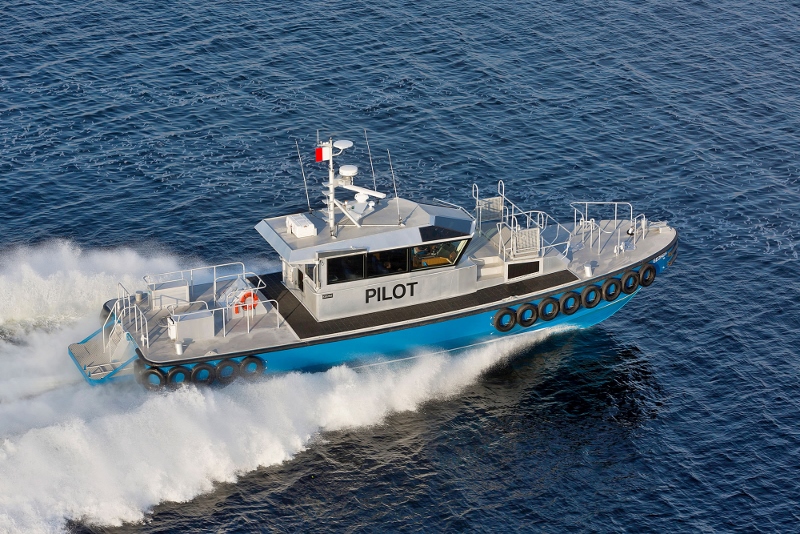Georgia ship pilots, New England offshore lobster fishermen and their boat builders will get three more years to meet Tier 4 emission standards for their lightweight and high-powered diesel engines, with a proposed extension from the U.S. Environmental Protection Agency.
The offshore lobster fishery needs engines beyond the 804-hp threshold where Tier 4 standards apply. But the specialized hull designs and deck layout required in the fishery leaves little space below for the selective catalytic reduction (SCR) technology that’s being used in ferries and tugboats to reduce particulates and gas emissions.
The same goes for the Savannah Bar Pilots, who serve Georgia’s rapidly growing ports and face a set of design challenges and constraints in planning to update their fleet.
“We’re limited to 65’ (hull length) with the right whale speed restrictions,” said pilots association president Trey Thompson, whose colleagues transit waters frequented by the migratory, extremely endangered marine mammals.
The ride out requires lots of horsepower. “We’ve got a 17 mile run so we need 35 knots,” Thompson said, so the pilots need a 1,400-hp propulsion package.
Given the current state of SCR technology, the pilots’ builder Vigor in Seattle cannot meet both Tier 4 and the need to update the fleet, said Thompson.
But with the time extension, “I think we can go ahead and get a Tier 3 replacement in the near term, and look forward to new advances for a boat in the 2020s, he said.
SCR emission controls typically include bulky filters, exhaust gas handling equipment and tanks carrying urea catalyst, and present a challenge even to naval architects working on larger vessels.
“This proposal will provide boat builders the flexibility they need to meet EPA standards while they continue to manufacture products that are critical to marine industries,” said EPA Administrator Andrew Wheeler in announcing the proposal Monday. “This action reflects our mindset that environmental progress is best achieved by working with states and the regulated community to advance sound and attainable regulatory solutions."
The extension for pilot boats was sought by Rep. Earl ‘Buddy’ Carter, R-Ga., on behalf of the Savannah Bar Pilots. The pilots for the Port of Savannah are looking to replace the oldest 40-year-old vessel in their fleet of four, but have not been able to find a design and builder who can meet both their requirements and Tier 4 emissions requirements tp deliver a new boat in time.
It’s not the first time Carter has interceded to help his port get a regulatory workaround from the Trump administration. Chinese-built container ship cranes recently purchased by the Georgia Ports Authority will be exempted from an additional 10 percent tariff from U.S. authorities.
The authority needs the new cranes to handle growing container volume, which was up 7.3 percent in the fiscal year that ended June 30 – the larger trade war notwithstanding. In announcing the deal Aug. 13 Carter said he contacted the administration’s trade representative Robert Lighthizer to ask for the tariff exemption break because “if the cranes were included, it could have added millions of dollars to the purchase of the new cranes.
"The Port of Savannah is the third largest and fastest growing port in the United States," said Carter. "These new cranes are critical to ensure the port is able to keep up with the continued growth.”
In the announcement EPA officials provide details of their reasoning behind the pilot boat measure.
“Use of a new Tier 4 engine and accompanying catalyst system requires a thorough reassessment of vessel design to accomplish a proper balance between vessel length and total propulsion power. For example, the vessel would need engines with higher maximum power output if the vessel’s length, width, or depth increases to accommodate the new engine and the accompanying catalyst system.”
“A complicating factor for pilot boats is other federal, state, or local programs that impose speed restrictions on vessels for certain vessel lengths. Specifically, pilot boats that operate in certain coastal areas are subject to whale-strike avoidance rules that are designed to protect migrating and calving right whales. In designated areas off the coast of Georgia, for example, vessels 65 feet and longer may not exceed an operating speed of 10 knots from November 1 to April 30 each year.”
That holds the pilots to 65’ boats, so the industry needs more time to evolve solutions, the EPA concluded.




